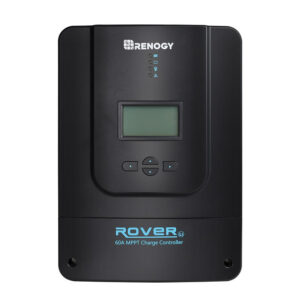The Voyager 20A is a top-tier 20-amp charge controller, rated IP67, making it perfect for outdoor use in conditions involving water spray, rain, and condensation. Featuring advanced PWM technology, it supports both 12V and 24V off-grid applications and is compatible with four different battery types, including Lithium Iron Phosphate. With built-in protections for the solar panel, battery, and controller, the Voyager 20A ensures the longevity of your system. PLEASE NOTE: For lithium batteries, it is essential to manually set the voltage for optimal charging.
Note: Please set the voltage manually to charge lithium batteries.

Leveraging intelligent PWM technology, the Voyager 20A offers 4-stage charging (Bulk, Absorption, Float, and Equalization) to protect the battery. It also includes multiple electronic protections for the battery, controller, and PV system, ensuring safe and efficient charging and usage.

The Renogy Voyager PWM Waterproof Controller is compact and lightweight, making it perfect for applications with limited space. With a weight of only 0.55lb, a height of 3.84 inches and a width of 6.08 inches, this controller is ready to be installed in small spaces.

The Voyager PWM Waterproof Controller is a common positive ground charge controller, beneficial in ensuring charging safety.

Equipped with a Remote Temperature Sensor Port, the Voyager 20A measures battery temperature in real-time and uses this data for precise temperature compensation, ensuring stable and consistent charging performance.

In a 12V system, the Voyager PWM Waterproof Controller consumes just 0.22W/h or 1.92kWh per year (365 days), making it highly energy-efficient while effectively charging your battery.

The Voyager PWM Waterproof Controller supports both 12V and 24V systems and automatically detects system voltage when connected to Gel, AGM, or Flooded battery banks. REMEMBER: For lithium batteries, please manually set the voltage to ensure proper charging.
- For users with a PWM controller in their solar system, we highly recommend connecting the solar panels in parallel. This setup helps maintain the PV output voltage, allowing the controller to operate at optimal efficiency.
- Never install the controller in a sealed enclosure with flooded batteries as gas can accumulate and there is a risk of explosion.
- The solar controller should be installed as near the battery as possible to avoid efficiency loss.
- Incorrectly setting the battery type on the controller may damage your battery. The system’s auto-recognition feature is only compatible with Gel, AGM, and Flooded batteries. When using the Voyager to charge a lithium battery bank, make sure to manually set the system voltage. Otherwise, an over-discharged lithium battery may not be activated.
- To ensure optimal controller performance, avoid any damage or wear to the wires connected to the controller. Ensure all terminals are tightly secured, and regularly inspect for loose, broken, or burnt connections. It is a good idea to sporadically clean the controller’s case with a damp cloth to keep it in good condition.



Reviews
There are no reviews yet.